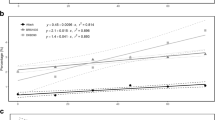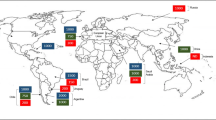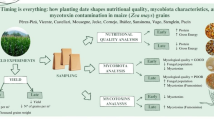Abstract
Maize cultivation in Tanzania is hampered by the presence of maize stalk borer (Busseola fusca) and Fusarium verticillioides, causing ear, kernel and stalk damage. Furthermore, accumulation of fumonisin mycotoxins deteriorates grain quality. Optimized agronomic practices remain the primary line of defense against pests and diseases. Therefore, the aim of this study was to gain insight into the effects of hybrid, sowing and harvest date on injuries due to maize stalk borer, Fusarium verticillioides symptoms and fumonisin contamination in maize grown in Tanzania. The analyses of the data collected during two growing seasons (2013 and 2014) showed early sowing and early harvesting as important measures for minimizing these problems. Although the impact of hybrid was not always significant, the early maturing hybrid STUKA M1 was consistently less susceptible compared to the hybrid STAHA. Correlation analysis revealed that stalk borer injuries, Fusarium symptoms and fumonisin levels were positively associated. The associations between yield and stalk borer injuries, Fusarium symptoms and fumonisin levels were negative, indicating that besides the mycotoxin issues, the insect and fungal pathogen also contribute to yield losses.



Similar content being viewed by others
References
Alakonya AE, Monda EO, Ajanga S (2008) Effect of delayed harvesting on maize ear rot in Western Kenya. American-Eurasian Journal of Agricultural, Environmental Sciences 4:372–380
Bankole S, Schollenberger M, Drochner W (2006) Mycotoxins in food systems in Sub Saharan Africa: A review. Mycotoxin Research 22:163–169
Blandino M, Reyneri A, Vanara F, Pascale M, Haidukowski M, Saporiti M (2008) Effect of sowing date and insecticide application against European corn borer (Lepidoptera: Crambidae) on fumonisin contamination in maize kernels. Crop Protection 27:1432–1436
Blandino M, Reyneri A, Vanara F (2009) Effect of sowing time on toxigenic fungal infection and mycotoxin contamination of maize kernels. Journal of Phytopathology 157:7–14
Bryden WL (2007) Mycotoxins in the food chain: Human health implications. Asia Pacific Journal of Clinical Nutrition 16:95–101
Calatayud P-A, Le Ru BP, van den Berg J, Schulthess F (2014) Ecology of the African maize stalk borer Busseola fusca (Lepidoptera: Noctuidae) with special reference to insect-plant interactions. Insects 5:539–563
Chung C-L, Jamann T, Longfellow J, Nelson R (2010) Characterization and fine-mapping of a resistance locus for northern leaf blight in maize bin 806. Theoretical and Applied Genetics 121:205–227
Codex Alimentarius Commission (2016) CODE of practice for the prevention and reduction of mycotoxin contamination in cereals
da Rocha MEB, da Chagas Oliveira Freire F, Erlan Feitosa Maia F, Florindo Guedes MI, Rondina D (2014) Mycotoxins and their effects on human and animal health. Food Control 36:159–165
De Curtis F, De Cicco V, Haidukowski M, Pascale M, Somma S, Moretti A (2011) Effects of agrochemical treatments on the occurrence of Fusarium ear rot and fumonisin contamination of maize in Southern Italy. Field Crops Research 123:161–169
Degraeve S, Madege RR, Audenaert K, Kamala A, Ortiz J, Kimanya M, Tiisekwa B, De Meulenaer B, Haesaert G (2016) Impact of local pre-harvest management practices in maize on the occurrence of Fusarium species and associated mycotoxins in two agro-ecosystems in Tanzania. Food Control 59:225–233
Desjardins AE, Munkvold GP, Plattner RD, Proctor RH (2002) FUM1-a gene required for fumonisin biosynthesis but not for maize ear rot and ear infection by Gibberella moniliformis in field tests. Molecular Plant Microbe Interactions 15:1157–1164
Domijan AM (2012) Fumonisin B1: A neurotoxic mycotoxin. Arhiv za Higijenu Rada i Toksikologiju 63:531–544
Dowd PF (2003) Insect management to facilitate preharvest mycotoxin management. Toxin Reviews 22:327–350
Duncan KE, Howard RJ (2010) Biology of maize kernel infection by Fusarium verticillioides. Molecular Plant Microbe Interactions 23:6–16
Edwards SG, Godley NP (2010) Reduction of Fusarium head blight and deoxynivalenol in wheat with early fungicide applications of prothioconazole. Food Additives and Contaminants 27:629–635
Fandohan P, Gnonlonfin B, Hell K, Marasas WF, Wingfield MJ (2005) Natural occurrence of Fusarium and subsequent fumonisin contamination in preharvest and stored maize in Benin, West Africa. International Journal of Food Microbiology 99:173–183
Henry WB, Ji X, Ni X, Fountain JC, Li H, Abbas HK, Lee RD, Scully D (2009) Evaluation of maize inbred lines for resistance to Aspergillus and Fusarium Ear Rot and mycotoxin. Accumulation Agronomy Journal 101:1219–1226
Jasemi M, Darabi F, Naseri R, Naseirad H, Bazdar S (2013) Effect of planting date and nitrogen fertilizer application on grain yield and yield components in maize (SC 704). American-Eurasian Journal of Agriculture and Environmental Science 13:914–919
Kaaya AN, Warren HL, Kyamanywa S, Kyamuhangire W (2005) The effect of delayed harvest on moisture content insect damage moulds and aflatoxin contamination of maize in Mayuge district of Uganda. Journal of the Science of Food and Agriculture 85:2595–2599
Kamala A, Ortiz J, Kimanya M, Haesaert G, Donoso S, Tiisekwa B, De Meulenaer B (2015) Multiple mycotoxin co-occurrence in maize grown in three agro-ecological zones of Tanzania. Food Control 54:208–215
Kamala A, Kimanya M, Haesaert G, Tiisekwa B, Madege R, Degraeve S, Cyprian C, De Meulenaer B (2016) Local post-harvest practices associated with aflatoxin and fumonisin contamination of maize in three agro ecological zones of Tanzania. Food Additives and Contaminants - Part A Chemistry Analysis Control Exposure and Risk Assessment 33:551–559
Kimanya ME, De Meulenaer B, Roberfroid D, Lachat C, Kolsteren P (2010) Fumonisin exposure through maize in complementary foods is inversely associated with linear growth of infants in Tanzania. Molecular Nutrition and Food Research 54:1659–1667
Kinasha AD, Manji KP (2002) The incidence and pattern of neural tube defects in Dar es Salaam, Tanzania. European Journal of Pediatric Surgery 12:S38–S39
Magoha H, Kimanya M, De Meulenaer B, Roberfroid D, Lachat C, Kolsteren P (2016) Risk of dietary exposure to aflatoxins and fumonisins in infants less than 6 months of age in Rombo Northern Tanzania. Maternal and Child Nutrition 12:516–527
Marín S, Magan N, Bellí N, Ramos AJ, Canela R, Sanchis V (1999) Two-dimensional profiles of fumonisin B1 production by Fusarium moniliforme and Fusarium proliferatum in relation to environmental factors and potential for modelling toxin formation in maize grain. International Journal of Food Microbiology 51:159–167
Marín S, Albareda X, Ramis AJ, Sanchis V (2001) Impact of environment and interactions of Fusarium verticillioides and Fusarium proliferatum with Aspergillus parasiticus on fumonisin B1 and aflatoxins on maize grain. Journal of the Science of Food and Agriculture 81:1060–1068
Miller SS, Reid LM, Harris LJ (2007) Colonization of maize silks by Fusarium graminearum the causative organism of Gibberella ear rot. Botany 85:369–376
Mohseni M, Haddadi MH, Zamani M (2016) Evaluation on reaction of early maturing maize lines and hybrids to Fusarium ear rot. Agricultural Advances 5:215–220
Mourice SK, Rweyemamu CL, Tumbo SD, Amuri N (2014) Maize cultivar specific parameters for decision support system for agrotechnology transfer (DSSAT) application in Tanzania. American Journal of Plant Sciences 5:55–65
Mukanga M, Derera J, Tongoona P, Laing MD (2010) A survey of pre-harvest ear rot diseases of maize and associated mycotoxins in south and central Zambia International. Journal of Food Microbiology 141:213–221
Munkvold GP (2003) Cultural and genetic approaches to managing mycotoxins in maize. Annual Review of Phytopathology 41:99–116
Murillo-Williams A, Munkvold GP (2008) Systemic infection by Fusarium verticillioides in maize plants grown under three temperature regimes. Plant Disease 92:1695–1700
Oluwaranti A, Fakorede MAB, Badu-Apraku B (2008) Grain yield of maize hybrids of different maturity groups under marginal rainfall conditions. Journal of Agricultural Sciences Belgrade 53:183–191
Oren L, Ezrati S, Cohen D, Sharon A (2003) Early events in the Fusarium verticillioides -maize interaction characterized by using a green fluorescent protein-expressing transgenic isolate. Applied and Environmental Microbiology 69:1695–1701
Parsons MW, Munkvold GP (2010) Associations of planting date drought stress and insects with Fusarium ear rot and fumonisin B1 contamination in California maize. Food Additives and Contaminants 27:591–607
Parsons MW, Munkvold GP (2012) Effects of planting date and environmental factors on fusarium ear rot symptoms and fumonisin B1 accumulation in maize grown in six North American locations. Plant Pathology 61:1130–1142
Pierre J (1999) A novel rate model of temperature-dependent development for arthropods. Environmental Entomology 28:22–29
Reid LM, Woldemariam T, Zhu X, Stewart DW, Schaafsma AW (2002) Effect of inoculation time and point of entry on disease severity in Fusarium graminearum, Fusarium verticillioides or Fusarium subglutinans inoculated maize ears. Canadian Journal of Plant Pathology 24:162–167
Samapundo S, Devlieghere F, De Meulenaer B, Geeraerd AH, Van Impe JF, Debevere JM (2005) Predictive modelling of the combined effect of water activity and temperature on the radial growth of Fusarium verticilliodes and F. proliferatum on corn. International Journal of Food Microbiology 105:35–52
Samapundo S, De Meulenaer B, De Muer N, Debevere J, Devlieghere F (2006) Influence of experimental parameters on the fluorescence response and recovery of the high-performance liquid chromatography analysis of fumonisin B1. Journal of Chromatography A 1109:312–316
Schjoth JE, Visconti A, Sundheim L (2009) Fumonisins in maize in relation to climate planting time and hybrids in two agro-ecological zones in Zambia. Mycopathologia 167:209–219
Schjth JE, Tronsmo AM, Sundheim L (2008) Resistance to Fusarium verticillioides in 20 Zambian Maize Hybrids. Journal of Phytopathology 156:470–479
Shirima CP, Kimanya ME, Kinabo J, L Routledge MN, Srey C, Wild CP, Gong YY (2013) Dietary exposure to aflatoxin and fumonisin among Tanzanian children as determined using biomarkers of exposure. Molecular Nutrition & Food Research 57:1874–1881
Soriano JM, González L, Catalá AI (2005) Mechanism of action of sphingolipids and their metabolites in the toxicity of fumonisin B1. Progress in Lipid Research 44:345–356
Sydenham EW, Shephard GS, Thiel PG, Stockenström S, Snijman PW, Van Schalkwyk DJ (1996) Liquid chromatographic determination of fumonisins B1 B2 and B3 in corn: AOAC-IUPAC Collaborative Study. Journal of AOAC International 79:688–696
Tesso T, Ochanda N, Clafilin L, Tuinstra M (2009) An improved method for screening Fusarium stalk rot resistance in grain sorghum (Sorghum bicolor [ L ] Moench). African Journal of Plant Science 3:254–262
Xu H, Twine TE, Girvetz E (2016) Climate Change and Maize Yield in Iowa. PLoS One 11:1–20
Yates IEE, Sparks D (2008) Fusarium verticillioides dissemination among maize ears of field-grown plants. Crop Protection 27:606–613
Acknowledgements
The authors are grateful for the research funding provided by VLIR (ZEIN2011PR388). The technical support given during field and laboratory activities at Sokoine University of Agriculture (Tanzania), Tanzania Drugs Authority (Tanzania) and University of Ghent (Belgium) is highly appreciated.
Author information
Authors and Affiliations
Corresponding author
Additional information
Section Editor: Zhang Hao
Electronic supplementary material
Fig. A1
Effect of harvest date (H1, H2, H3), sowing date (S1, S2, S3, S4), and maize hybrid (STAHA, STUKA M1) on Fusarium stalk (a), ear (b) and kernel (c) rot during 2013. (PNG 40 kb)
Fig. A2
Effect of harvest date (H1, H2, H3), sowing date (S1, S2, S3, S4), and maize hybrid (STAHA, STUKA M1) on Fusarium stalk (a), ear (b) and kernel (c) rot during 2014. (PNG 42 kb)
Fig. A3
Effect of sowing date (S1, S2, S3, S4), and maize hybrid (STAHA, STUKA M1) on biomass of Fusarium verticillioides in maize kernels (pg DNA per g maize kernels) across two seasons (2013(a), 2014(b)). (PNG 52 kb)
Fig. A4
Effect of harvest date (H1, H2, H3), sowing date (S1, S2, S3, S4), and maize hybrid (STAHA, STUKA M1) on total fumonisin (FB) content during 2013. (PNG 32 kb)
Fig A5
Effect of harvest date (H1, H2, H3), sowing date (S1, S2, S3, S4), and maize hybrid (STAHA, STUKA M1) on total fumonisin (FB) content during 2014. (PNG 36 kb)
Fig A6
Effect of harvest date (H1, H2, H3), sowing date (S1, S2, S3, S4), and maize hybrid (STAHA, STUKA M1) on maize yield (ton/ha) during 2013. (PNG 36 kb)
Fig. A7
Effect of harvest date (H1, H2, H3), sowing date (S1, S2, S3, S4), and maize hybrid (STAHA, STUKA M1) on maize yield (ton/ha) during 2014. (PNG 35 kb)
Rights and permissions
About this article
Cite this article
Madege, R.R., Landschoot, S., Kimanya, M. et al. Early sowing and harvesting as effective measures to reduce stalk borer injury, Fusarium verticillioides incidence and associated fumonisin production in maize. Trop. plant pathol. 44, 151–161 (2019). https://doi.org/10.1007/s40858-018-0233-1
Received:
Accepted:
Published:
Issue Date:
DOI: https://doi.org/10.1007/s40858-018-0233-1




